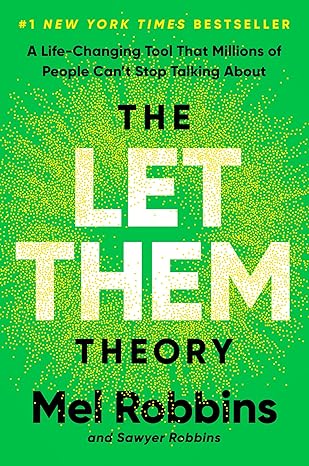The Let Them Theory by Mel Robbins: Embracing Self-Empowerment
Mel Robbins, a renowned motivational speaker, author, and behavioural science expert, has once again captivated audiences with her latest work, The Let Them Theory.
In this ground-breaking book, Robbins presents an innovative approach to personal growth and self-empowerment by urging readers to focus not on controlling their circumstances, but on letting go of the need to control others.
This theory aims to help individuals unlock their potential, find peace of mind, and ultimately live a more fulfilling life.
In this summary, we’ll delve into the core principles of The Let Them Theory and explore how Robbins’ teachings can lead to lasting transformations. Along the way, we will highlight actionable insights from the book and how you can apply them to your own life.
If you’re looking for a way to regain control over your happiness and take charge of your own personal growth, this book might just be the key you’ve been searching for.
What is The Let Them Theory?
The Let Them Theory is a radical shift in thinking that encourages people to stop worrying about changing others and instead focus on their own actions and responses.
Robbins explains that much of the suffering we experience in life comes from trying to control things that are beyond our power, especially the behaviour of other people.
In fact, the struggle to control others only serves to create frustration, stress, and resentment. Robbins believes that in order to move forward, individuals need to release these burdens and focus on letting others be who they are.
At its core, the Let Them Theory is about taking responsibility for yourself, relinquishing the desire to fix or control others, and embracing the freedom that comes with self-empowerment.
By letting go of control over external factors, you can redirect your energy toward personal growth, emotional resilience, and healthier relationships.
Why Control is a Trap
Robbins begins by addressing the universal tendency to want to control our environment, relationships, and circumstances. We often do this out of fear, insecurity, or the belief that we can shape the world around us according to our desires.
However, Robbins asserts that control is an illusion—a construct that actually limits our growth.
She highlights the many ways in which people try to control others, such as attempting to change their partner’s behaviour, fix the problems of a friend, or “manage” the actions of co-workers.
Robbins shows how these behaviours are rooted in our deep desire for validation, certainty, and safety. Yet, despite our best efforts, people rarely change unless they want to. This leads to frustration, disappointment, and a lack of fulfilment.
According to Robbins, this struggle is not only exhausting but also self-defeating. It creates a cycle of dependency, where you are constantly focused on things you cannot change, while neglecting the areas of your life that you can control: your own thoughts, emotions, and responses.

The Power of Letting Go
The Let Them Theory is ultimately about relinquishing the need to control others and focusing on what you can change—yourself. Robbins suggests that by letting go of control, you can reclaim your personal power and create the life you truly desire.
One of the key concepts Robbins introduces is the idea of emotional sovereignty. Emotional sovereignty is the practice of taking responsibility for your emotions and reactions, rather than relying on external circumstances or other people to dictate how you feel.
By embracing this, you can break free from emotional reactivity and experience more peace and clarity in your life.
This shift requires a mindset change—a move from seeking validation from others to becoming your own source of approval. Robbins encourages readers to cultivate self-compassion, practice mindfulness, and focus on personal development.
When you stop worrying about others’ actions, you open up space for your own growth.
Practical Steps for Letting Go
Robbins offers several practical strategies for implementing the Let Them Theory in your daily life. Here are a few key takeaways that can help you begin your journey toward emotional freedom:
1. Recognise the Illusion of Control
The first step is recognising that you do not have control over the thoughts, actions, or behaviours of others. This awareness is liberating because it allows you to stop feeling responsible for others’ choices and stop internalising their actions.
By acknowledging the limits of your control, you free yourself from the burden of trying to fix things that are beyond your influence.
2. Focus on Your Own Actions
Instead of focusing on what others are doing, turn your attention to what you can control: your own actions. What decisions can you make today to move closer to your goals? What can you do to take better care of your mental and physical health?
Robbins encourages readers to concentrate on these areas of influence, which ultimately empower you to make meaningful changes in your life.
3. Practice Mindfulness and Letting Go
Mindfulness is a powerful tool for cultivating emotional sovereignty. Robbins recommends adopting mindfulness practices that help you stay present in the moment and detach from the need to control external circumstances.
Whether through meditation, breathing exercises, or journaling, these practices allow you to release the stress associated with trying to control others and focus on what you can manage in the here and now.
4. Establish Healthy Boundaries
One of the core themes in the book is the importance of setting healthy boundaries. Letting others be who they are means respecting their autonomy, even if their actions don’t align with your desires.
This requires strong boundaries—both in how you interact with others and in protecting your emotional energy.
Robbins emphasises that boundaries are essential for maintaining self-respect and emotional well-being.

Real-Life Examples of Letting Go
To illustrate the effectiveness of The Let Them Theory, Robbins includes several real-life stories from her own life and the lives of others. One such example is a case study of a woman who struggled with controlling her partner’s behaviour.
Despite her efforts, her partner’s actions never aligned with her expectations, and this caused significant strain in their relationship.
After reading Robbins’ work, the woman shifted her focus inward, working on herself instead of trying to change her partner.
Over time, this shift improved her emotional well-being and ultimately led to a more harmonious relationship.
Another example Robbins shares is about a manager at a tech company who was constantly frustrated by his team’s lack of initiative. Instead of continuing to micromanage his employees, the manager decided to let them take ownership of their projects.
This not only empowered his team members but also led to a more innovative and productive work environment. Robbins explains that when we stop trying to control others, we often find that they are more than capable of thriving on their own.
The Benefits of Embracing The Let Them Theory
By embracing the principles of the Let Them Theory, Robbins argues that individuals can experience numerous benefits:
Emotional freedom: Letting go of control over others’ actions allows you to release resentment and frustration, leading to emotional peace and clarity.
Stronger relationships: When you stop trying to change people, you create space for more authentic and fulfilling connections.
Increased self-awareness: Focusing on yourself and your responses fosters personal growth, helping you to become more emotionally resilient and self-assured.
Empowerment: As you take responsibility for your own actions and emotions, you gain greater control over your life and your future.
Conclusion
In The Let Them Theory, Mel Robbins offers a transformative perspective on self-empowerment, urging readers to release the need to control others and instead focus on what they can change: themselves.
By adopting this mindset, individuals can experience greater emotional freedom, stronger relationships, and a deeper sense of fulfilment. Through practical steps, real-life examples, and actionable advice, Robbins provides a roadmap for personal growth that anyone can follow.
If you’re ready to let go of control and embrace the power of self-empowerment, The Let Them Theory is a must-read.
You can purchase your copy today here, and start your journey toward a more fulfilling and peaceful life.
Dr Tom Barber is a #1 bestselling author, integrative and existential psychotherapist and coach, supervisor, researcher, speaker, and co-founder of Self Help School. His work has spanned nearing 30 years, in which he has focussed on helping people all over the world to improve their knowledge and understanding of their psychological worlds. Tom regularly delivers courses and lectures in the UK, USA, Canada, Mexico, and across Europe. In addition, he maintains a private therapy and coaching consultancy from his base in Essex, and online.


